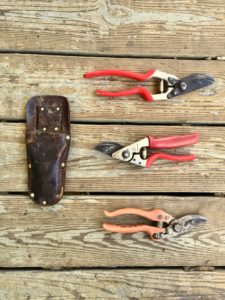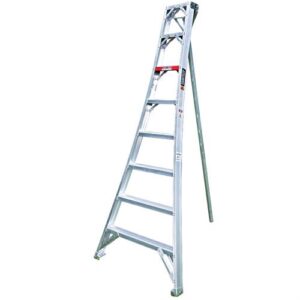Many modern varieties of fruit trees benefit from pruning. How to prune a fruit tree depends on the age, size, and type of tree, and your desired results. There are several reasons to prune, including:
Shape the tree as it grows
Stimulate growth
Improve light and airflow around flowers/fruits
Remove dead or diseased branches
Give roots a chance to get established without stress of lots of branches to feed (for newly transplanted bare root trees)
Participating in a hands-on Permaculture course with experienced instructors is a great way to learn the nuances of pruning.
Why Winter Pruning?


Most fruit trees are dormant during the winter, with branches free of leaves. As a result, it’s much easier to see what you’re doing as you prune during this time. In particular, leafless branches mean you can step back and see the overall shape of the tree as you go. Furthermore, pruning in the wintertime stimulates growth of the pruned branch. It’s especially important to prune young trees to encourage a healthy, fruitful, easy to harvest form as they grow. In this case, the branches that shoot out as a result of early winter pruning will become the main branches of the mature tree. If these branches are balanced and at appropriate angles, later pruning will be easier and overall tree growth and health will be optimal.
What Kinds of Trees Need Pruning?
Many kinds of fruit trees benefit from winter pruning, but not all! Pome fruits (apples, pears, quince, etc.), stone fruits (peaches, plums, nectarines, etc.), persimmons, and paw paws all are appropriate for winter pruning. Berries and other bushes can also benefit from pruning, but the approach is different than with trees. How to prune a fruit tree depends many factors:
The natural shape of the tree
The kind of wood that bears fruit (first year growth, later growth, spurs, etc.)
How easily the tree heals over wounds
Your expected/desired size of the mature tree
Variety-specific factors that vary from fruit tree to fruit tree
Tools for Fruit Tree Pruning


Note: Some of the links below are part of an Amazon affiliate program. When you click them, we benefit (at no cost to you). If you want to find these items locally, more power to you! If you’re going to buy them online, clicking-through here helps us continue offering free information and resources to everyone.
Perhaps the most important tool to have on hand for fruit tree pruning is a sharpening stone. Whatever tool you use to make cuts, make sure it is very sharp! It’s easier to make exact cuts with a sharp blade, and clean cuts are much easier for a tree to heal over.


A good quality, thin-bladed pruning saw is the best tool for accurate cuts on thicker branches. Accompany this with a pair of bypass pruners and a sharp knife to make a good pruning-tool team. Use the pruners for cutting twigs that are too small to saw. The knife will be helpful to clean up the edges of cuts made by the other tools. Remember: the cleaner the cut, the better for the tree. This includes stray bits of bark.
The Orchard Ladder


Smaller trees can usually be pruned from the ground, while larger ones require a ladder or climbing. An orchard ladder is a specially made tool that makes pruning larger trees, especially on uneven ground, much easier. If you just have a couple of trees, or if your orchard is on flat ground, you can use a step ladder. On the other hand, if you’re dealing with uneven ground, an orchard ladder is well worth the investment. They make harvesting from tall trees easier, too. Harvesting fruit without any kind of ladder may involve climbing, if you have standard (full-size), mature trees.
How to Prune a Fruit Tree – Basic Steps
These steps apply to any medium to large tree.
1. Take a step back and observe your tree.
Notice any dead or diseased branches. Look at the overall shape. Pay attention to the base to see if any suckers are shooting straight up from the rootstock, near the ground. Follow the branches and notice any water sprouts shooting straight up from along their length.
Get a picture in your mind’s eye of how you want the tree to look when you are done pruning: No dead or diseased limbs, free of suckers and water sprouts, balanced structure, no branches touching each other, plenty of light and airflow throughout.
Pruning a fruit tree is kind of like creating a living sculpture. Keep in mind that you should never remove more than 25% of the crown in any given year. If you have inherited a wildly overgrown old tree, it may take several years of pruning to get it into the shape that you want.
2. With your very sharp tools, cut away material, moving toward your goal.
When you remove entire limbs/branches, make your cut as flush with the main branch or trunk as possible, without cutting or abrading the trunk’s bark. Don’t leave any stubs! They are prone to rot and make trees more susceptible to contracting diseases. Plus, they don’t look nice. Pay attention to the buds on branches that you prune back. New growth always comes out of a bud, and the direction of that growth is determined by the orientation of the bud. Be sure to wash your tools with rubbing alcohol if you are dealing with any diseased material.
3. Take a step back, observe your tree.
Make any adjustments you may need to. Clean up any large branches you have removed. Smaller trimmings can be left in place as mulch, as long as they are not diseased. Envision a healthy, strong tree that is full of fruit in the summertime!




